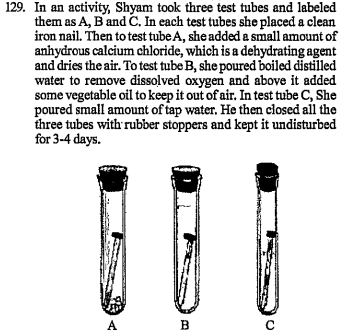Which of the following statements is correct?
All these things possess mass, shape and occupy space.
Both the living and the non-living things have a structural unit - cells in the living and molecules in the non-living things.
Cells do not exist in non-living things.
All the above
To determine which of the statements is correct, we will analyze each statement provided in the question.
1. Understanding Mass, Shape, and Space:
- The first statement claims that all things possess mass, shape, and occupy space. This is true for both living and non-living things. Everything we see in our environment, whether it's a tree, a rock, or a chair, has weight (mass), a form (shape), and takes up space.
- Conclusion: This statement is correct.
2. Structural Units in Living and Non-living Things:
- The second statement discusses structural units in living and non-living things. Living organisms are made up of cells, which are considered the fundamental units of life. Non-living things, on the other hand, are made up of molecules, which are smaller particles that combine to form various substances.
- Conclusion: This statement is also correct.
3. Existence of Cells in Non-living Things:
- The third statement asserts that cells do not exist in non-living things. This is indeed true because cells are unique to living organisms. Non-living things do not have cellular structures or protoplasts.
- Conclusion: This statement is correct as well.
Final Conclusion:
All three statements provided are correct. Therefore, we can conclude that the answer to the question is that all the statements are true.
---
- The first statement claims that all things possess mass, shape, and occupy space. This is true for both living and non-living things. Everything we see in our environment, whether it's a tree, a rock, or a chair, has weight (mass), a form (shape), and takes up space.
- Conclusion: This statement is correct.
- The second statement discusses structural units in living and non-living things. Living organisms are made up of cells, which are considered the fundamental units of life. Non-living things, on the other hand, are made up of molecules, which are smaller particles that combine to form various substances.
- Conclusion: This statement is also correct.
- The third statement asserts that cells do not exist in non-living things. This is indeed true because cells are unique to living organisms. Non-living things do not have cellular structures or protoplasts.
- Conclusion: This statement is correct as well.
All three statements provided are correct. Therefore, we can conclude that the answer to the question is that all the statements are true.
Topper's Solved these Questions
- BOOK - BETOPPERSCHAPTER - LIFE ON EARTHEXERCISE - CONCEPTIVE WORKSHEET14videos
LIFE ON EARTH
- BOOK - BETOPPERSCHAPTER - LIFE ON EARTHEXERCISE - SUMMATIVE WORKSHEET (MULTIPLE CHOICE QUESTIONS)5videos
LIFE ON EARTH
- BOOK - BETOPPERSCHAPTER - HEALTH AND HYGIENEEXERCISE - SUMMATIVE WORKSHEET34videos
HEALTH AND HYGIENE
- BOOK - BETOPPERSCHAPTER - OUR ENVIRONMENTEXERCISE - SUMMATIVE WORKSHEET (ANSWER THE FOLLOWING QUESTIONS:)24videos
OUR ENVIRONMENT
Similar Questions
Knowledge Check
- Question 1 - Select One
Which of the following statement is correct?
ANon renewable resources can never be replaced once they get used upBNon renewable resources can be replaced in million of yearsCNon renewable resources can be replaced in 50-100 years.DNon renewable resources can be replaced in 100-200 years - Question 2 - Select One
Which of the following statement is correct?
AMahakali Temple is famous for Sun MandirBMahakali Temple is famous for Kali MandirCMahakali Temple is famous for Shiv MandirDMahakali Temple is famous for Laxmi Mandir - Question 3 - Select One
Which of the following statement is correct?
AEarth has the largest number of satellitesBMars has the largest number of satellitesCJupiter has the largest number of satellitesDUranus has largest number of satellites

